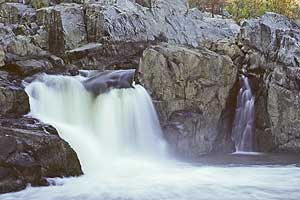The History of Great Falls Park
Today, the Great Falls of the Potomac stands as a natural wonder bringing awe and admiration of its power and beauty. In the mid 1700's the falls were seen as an obstruction to the navigation of the Potomac. Seeking a route to link the eastern seaboard with lands being settled in the Ohio valley, George Washington and other delegates solidified a plan to develop a system of canals on the Potomac, allowing navigation for over 200 miles. In 1785 the Patowmack Canal Company was formed, funds were acquired, and construction began. Shallow areas were improved by removing large rocks and debris, along with dredging some areas. Five bypasses and canals were engineered - at Little Falls, Great Falls, Seneca Falls, Shenandoah Falls, and House Falls.
The largest and most difficult to engineer was the Patowmack Canal of Great Falls. This canal was completed in 1802. For 26 years the canal operated lifting and lowering river boats loaded with cargos of corn, wheat, and rye flour, pig iron, tobacco, pork, beef, cast iron stoves and more. Considered to be the most significant engineering feat of the 18th century in America, the ruins of the Patowmack Canal may still be seen here at Great Falls Park.
In the early 1900's, two entrepreneurs by the names of John McLean and Steven Elkins, acquired the lands surrounding Great Falls and built an amusement park. Tourists traveled along a trolley from Georgetown to the park to see the spectacular Great Falls. Included in the park were overlook decks, an observation tower, a dance pavilion, a night light show, a wooden carousel, and a Lovers Lane along the Patowmack Canal ruins. The famous Dickey's Inn provided lodging and exquisite dinners. The amusement park was an instant overnight success. Trolley cars were often full, selling five tickets for 25 cents. After the coming of the automobile and several floods which severely damaged the park's structures, the amusement park was closed and eventually faded into history.
The land was eventually bought by the Potomac Edison Power Company (PEPCO) with plans to construct a hydroelectric dam. However, due to the hydrology and geology of the area, the site at Great Falls was determined to be unfit for hydroelectric development. Fairfax County Park Authority leased the land and continued operating as a park, allowing the public to visit the Great Falls and ride the carousel. In 1966, through an agreement with Fairfax County, the National Park Service acquired the lands, totaling 800 acres. In 1968 the visitor center was built.
In the following years, 15 miles of trails were constructed, and the Patowmack Canal locks were stabilized. The National Park Service now administers Great Falls Park, preserving and protecting the resources and providing for recreation and enjoyment of the park.
Visitor Information
The fifteen miles of hiking trails offer a variety of ways to explore Great Falls Park and the Patowmack Canal. Trail maps are available online and in the Visitor Center.
(This page was adapted from resources provided by the National Park Service.)
